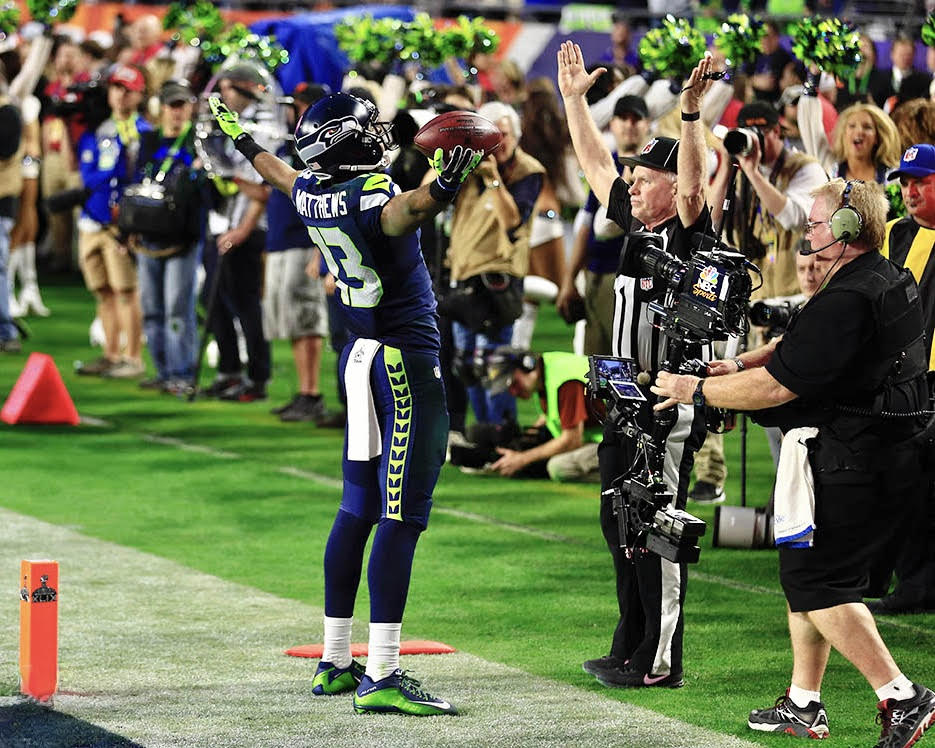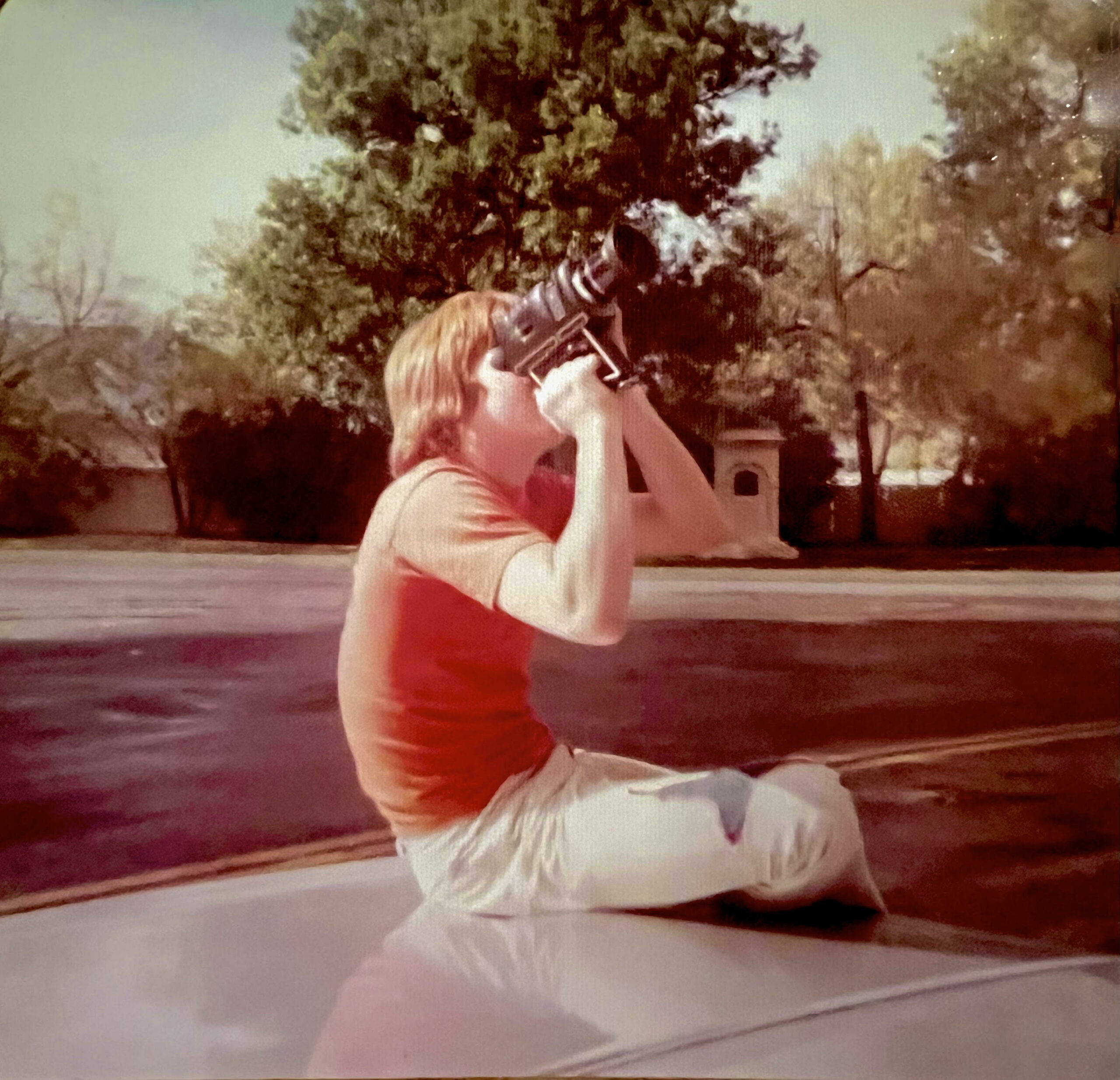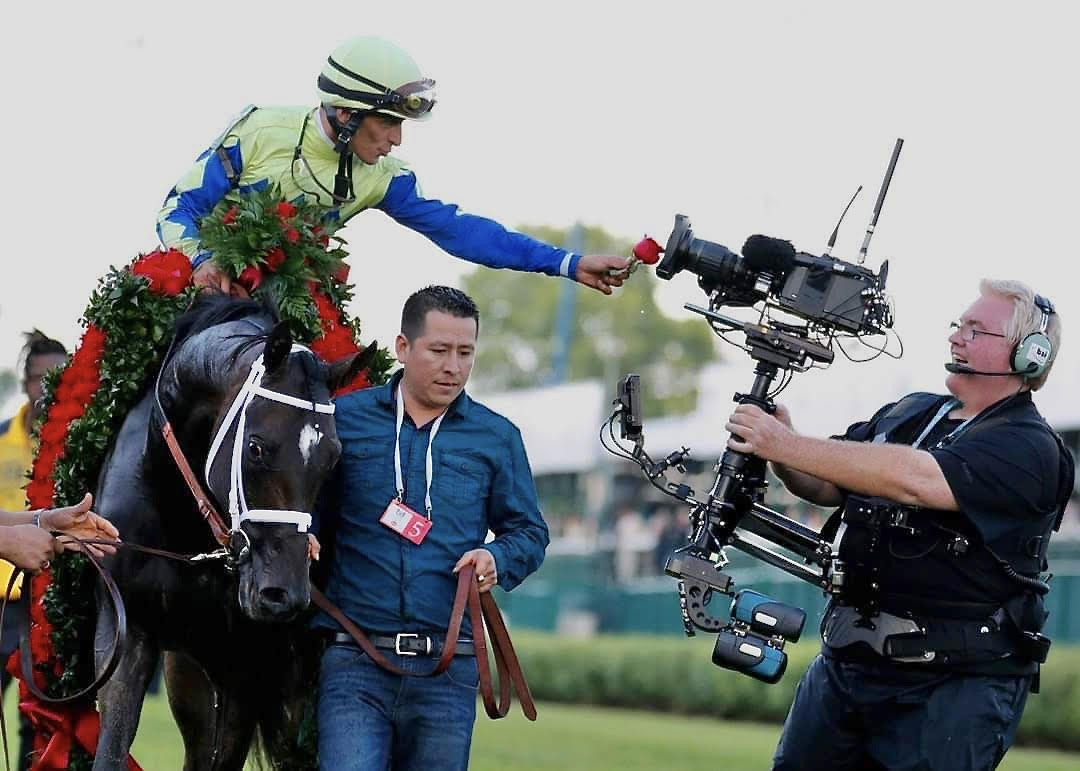Jeff Zachary
Technical Crafts
Year Inducted: 2023
It isn’t very often that a child who finds themselves in front of the camera becomes enraptured by what is going on behind the camera, but that is what happened to Sports Broadcasting Hall of Famer Jeff Zachary who, as a child, appeared in Armour hot dog commercials.
“I was more intrigued by the behind the scenes and shooting it,” he recalls.
That intrigue at a young age resulted in a Hall of Fame career as Zachary is considered one of the all-time-great Steadicam operators. He was the first person to bring Steadicam to NFL coverage, Super Bowls, PGA Golf, MLB All-Star Weekends and the Home Run Derby, the Kentucky Derby, FIFA World Soccer Finals, college football starting in 2006 at the BCS Rose Bowl Championship Game, the XFL, and the Jerry Lewis Labor Day Telethons. And he also was an innovator, creating specialty camera systems as well as playing a big role in 3D handheld, Steadicam and hard camera rig designs.
“I was always intrigued with adding lateral movement to a shot,” says Zachary of his love of running a Steadicam. “I was always thinking about if I could get 20 yards in front of the receiver so that when the ball drops in near me, I can take off and make it to the goal line with them, providing a lateral stabilized tracking shot.”
Zachary says he is grateful for Director Craig Janoff deciding to incorporate the Steadicam for the National Anthem and game coverage at Super Bowl XXXIV as it then led to Don Ohlmeyer and Drew Esocoff incorporating the Steadicam for the whole next NFL season. In turn, Esocoff and Fred Gaudelli, tapped it for the next 17 years for Monday Night Football and then Sunday Night Football.
“I am grateful for allof their support as well as the support of Hall of Famer Dick Ebersol, Mark Lazarus, Ken Goss, Mike Sheehan, Sam Flood, Mike Meehan, Pierre Moossa, John Roche, Tim DeKime, Diane Solomon and Rob Hyland,” he says. XFL Director John Gonzalez would also embrace Steadicam.
“Initially I was allowed on the sidelines, then onto the field, but only to the numbers,” he says. “Then after ‘good behavior’… then to the huddle… then to the endzone. Getting to that point took time and the trust of the NFL.”
Zachary has received 11 Sports Emmys, often working at some of the most important events in sports history. Among the highlights of his 47-year career as a camera operator and Steadicam operator are working the Ali vs. Holmes fight in 1980; FIFA World Cup Finals 1994; 26 NBA All-Star Games/Slam Dunk Contests; 12 Super Bowls; 15 Kentucky Derbys; 13 MLB All-Star Home Run Derbys; U.S. Open Golf; Indy 500; 36 years of ABC’s Monday Night Football, ESPN’s and NBC’s Sunday Night Football, Fox NFL, CBS NFL, and TNT NFL; 25 Pro Bowls; World League Football, XFL, NFL Network’s Thursday Night Football, and the College Football Association (CFA); F1 Las Vegas 1982 and F1 Phoenix 1989; nine Presidential Inaugurations; presidential debates; Democratic and Republican Conventions; four Olympics; 33 years of boxing; 7 Ironman Triathlons; The Masters, The Ryder Cup, and NCAA Final Four in 3D; X-Games; World Figure Skating; The Skins; the Goodwill Games; and two America’s Cups. He has also been an operator and producer on nine 3D feature concert films.
“For me, it all starts when a director, producer, and executives invite me to join them for their productions and to be able to experience some memorable moments, both in sports, historical events, and in film,” he says. “Without those invites, I don’t have the opportunities in my career that I am so grateful to have experienced.”
Feb 1, 2015; Glendale, AZ, USA; Seattle Seahawks wide receiver Chris Matthews (13) celebrates his touchdown catch during the second quarter in Super Bowl XLIX at University of Phoenix Stadium. Mandatory Credit: Andrew Weber-USA TODAY Sports
Key moments in Zachary’s career included in 1987 when ESPN Director Marc Payton and Producer John Wildhack asked him to join the Sunday Night Football package; in 1991 when Ken Aagaard, then working for NBC Sports, asked him to use the Steadicam for the first time on a live broadcast on a vehicle mount for the Moscow Peace Marathon; in 1992 when ABC’s Craig Janoff and Producer Kenny Wolfe asked him to join Monday Night Football; and working with legendary Director Roger Goodman with ABC on Super Bowl half time shows, Rose Bowl parades, Presidential inaugurations and funerals, and the Oprah Winfrey special with Michael Jackson. Zachary continues to this day to work on high-level historic and special events with Director Jeff Winn. And then there were 26 years working on the NBA Slam Dunk contest with Director Lonnie Dale and Producer Peter Lasser.
Says Gaudelli: “Jeff is one of the finest camera operators I ever worked with. He has many qualities that earned him induction to the Sports Broadcasting Hall of Fame, but none larger in my book than creating a position that didn’t exist and then turned into a mainstay camera on all major sports telecast.”
Lighting the Spark
It was a few years after the Armour hot dog commercials, in 1969, that Zachary’s future career came into sharper focus. His family was living in Las Vegas and his mother, Joyce Wilson-Zachary, took him to The Jerry Lewis MDA Labor Day Telethon.
“Susan Anton was singing and I told my mother, ‘I want to do that!’ and she then asked, being a singer herself, ‘be a singer?’ and I said, “To be a cameraman,” says Zachary. Zachary watched the floor monitors and the big screen on stage and what the camera operators were focusing on. He was intrigued.
“I was seeing the line cut when they were coming in and out of breaks,” he says.
Zachary’s formative years had several kismet moments, like attending the telethon or, getting a Super 8 film camera with a Slow Motion Feature at 12 years old. And in the seventh grade another teacher, Stan Johnson, asked if Zachary and some classmates wanted to turn two empty classrooms into a TV studio, which included childhood friends Steve Curtis (who later would become a production partner) and Allan Wells (who is now a TD in the entertainment industry). Zachary was working as an intern at KLAS Las Vegas and managed to get the station to donate some equipment.
“They donated a news desk, weather map, a small transmitter, and a switcher,” says Zachary. “We did weekly newscasts but mainly we recorded the local PBS station and transmitted it to 52 classrooms.”
Also very influential was the well-respected Mr. Bob Amblad, a local Vegas DJ and teacher, who invited Zachary and his partner Curtis to join him at his state-of-the-art broadcast facility.
In 1978 Zachary’s family owned their own real estate and video production company, called The Zachary Company, creating videos of the real-estate properties they were representing. The goal was to shoot high-quality video walk throughs of the properties and then provide buyers a way to see multiple listings without having to leave their air conditioned office in Vegas. Zachary, along with his father, John, his mother, production manager Tony Bond, and his brothers Tony and Roy developed an industry first: “Reel T Vision.” They also landed a contract with the Las Vegas Visitors and Convention Bureau and shot commercials for hotels, live entertainment shows, casinos and restaurants.
“The only way to accomplish that quality was to be fluid, and we tried a Dolly, but it was too time consuming to operate,” recalls Zachary. “My father and I were watching the movie Bound for Glory and there was a camera shot where the cameraman was walking through the set with real fluid movement. So, we purchased the product, a Steadicam, from Cinema Products.”
Amazingly, it was only the 13th Steadicam ever built and Steadicam inventor Garrett Brown (also a Sports Broadcasting Hall of Famer) worked on Bound for Glory. Two years later, the two would meet at the first Steadicam workshop that Brown and his wife, Ellen, ran in Rockport, Maine.
“I received very valuable advice from Garrett: to keep the horizon level at all times and how little pressure to apply to the gimbal,” says Zachary. “Those two pieces of advice really changed the way I was operating and shooting.”
In the Beginning…
The launching point for Zachary’s professional career was a local kids news program called Kids Watch, which he co-created, produced, directed, and shot with Curtis. They shot the show at KLAS Las Vegas (where they were interns) as well as KTNV Las Vegas and they were also co-MDA Youth State Chairmen for the MDA Jerry Lewis Association. Each year, there was an episode of Kids Watch that they dedicated to the Jerry Lewis Telethon.
“We received a letter from Jerry Lewis that he loved it and he wanted to make sure that we were invited to his production meeting for the Telethon that year,” says Zachary.
A year later, Packey Brown, the production manager for the Telethon, hired Zachary to work on the Telethon as both a handheld and Steadicam operator. He would work on the telethon for the next 13 years, most of them with legendary Director Arthur Forrest.
“I learned so much because of Jerry Lewis’s deep knowledge on every aspect of production, like to always be on headsets and always be ready and standing by for whatever he wanted to do,” recalls Zachary. “Working with Jerry prepared me for what was to come in my career. It was his attention to detail and the philosophy of always being ready and in position for any moment. All of the directors and producers that I have had the great fortune to work with had the same level of intensity and preparation of being ready for anything.”
That exposure, and being in the Las Vegas market, led to a call in 1980 to work on the Larry Holmes and Muhammad Ali fight documentary.
“It was my first sporting event with the Steadicam and once the fight started, I had free rein,” he says. “I eventually made my way to the apron and, as Ali was wrapping up his career, I had the opportunity to document it firsthand.”
In 1981 his sports-related career took another step when a ringside handheld cameraman was not able to work a fight for ESPN.
“When ESPN launched, there were a lot of new opportunities,” he recalls. “I was being offered everything from gymnastics to CART auto racing Indy car series to NASCAR and golf and working with directors, producers, mentors, and executives, like Hall of Famers Don Ohlmeyer, Steve Bornstein, Howard Katz, Steve Anderson, Scotty Connal, Drew Esocoff, and Geoff Mason. And there were others at ESPN who were key to my success, like Mike Wells, Steve Beim, Paul Spengler, Tim Corrigan, Terry Linger, and Ralph Mole.”
When ESPN’s College Football package in 1986 started up Zachary had a chance to work with Payton, Director Chip Dean and Hall of Fame Producer Gaudelli. While working with ESPN Zachary also was able to work with HBO (ultimately for 33 years) alongside Payton and Sports Broadcasting Hall of Famer Ross Greenburg on big-time fights like Marvin Hagler-Thomas Hearns, Sugar Ray Leonard-Marvin Hagler, and the legendary Mike Tyson fights.
By the time the late ’80s rolled around, Zachary seemed to be everywhere: with ESPN for Sunday Night Football, with NBC for the 1988 Summer Olympics in Seoul (using a new wireless system), and bringing Steadicam to golf coverage for the first time on the Golf Channel in 1997 with Director Emmett Loughran.
The 1992 America’s Cup in San Diego is another fond memory for Zachary. Following the U.S. win, led by Syndicate Owner Bill Koch, Koch did the unexpected and Zachary was there to capture it.
“I was working with ESPN’s Producer Jed Drake, Associate Producer Jamie Reynolds, and Director Doug Holmes and, after six months of racing, it’s time for the trophy presentation,” he says. “I see someone running across the boat at a speed that means he is definitely not going to be able to stay on the boat. I just stayed with it as Koch went off the boat and swam to the dock, to hoist the America’s Cup. That was a unique and very exciting moment.”
Capturing Steadicam shots at Triple Crown races was always a challenge due to the track as well as navigating in between horses.
In 1997, Zachary had the chance to do another first as legendary ABC Sports Director Craig Janoff brought the Steadicam to the post parades at the Triple Crown races. Zachary had covered the Kentucky Derby that year with a handheld and he suggested using the Steadicam to get a more stabilized image, especially going through the deep sand, for the next race.
“The Steadicam has been in place since that day, as it was the perfect tool for that shot,” says Zachary.
Adds Janoff: “Jeff’s energy and commitment was key to the success of the shows he resided on and the networks and viewers benefited greatly! He brought a great vibe to our telecasts and always demonstrated a top-flight attitude.”
An Innovator by Trade
Always an innovator (in 1979, he was part of a design team for a Steadicam helicopter mount), he also introduced, along with his longtime partner in business and in life (and Sports Broadcasting Hall of Famer) Deena Sheldon, the RoverCam at CBS’s PGA Championship and Fox’s US Open Golf, inventing the BoatCam where it has been used for NBC’s Super Bowl LVI and CBS’s Golf coverage, providing a new perspective for sports coverage. And he and Deena continue to innovate, working with Canon’s Rich Eilers, and Cartoni’s Elisbetta Cartoni and Jacques Goyard, who have all been very supportive in new ventures.
He was also part of the team and instrumental in contributing to the design and operating, for Innovator Vince Pace, ASC and Patrick Campbell, the first 3D Steadicam used on the U23D Concert Film; Hannah Montana and Miley Cyrus: Best of Both Worlds Concert, in 3D; and Cirque du Soleil: Worlds Away, in 3D. He was also the first to demo it in 3D for various sports, such as the NFL, NASCAR, NBA, X Games, Tennis, Golf, WWE, and MotoGP.
Pace and Oscar Winning Director James Cameron brought Zachary and Sheldon on as co-VPs of the Sports and Entertainment Division of the newly formed Cameron|Pace Group. The pair played a major role in producing and shooting live 3D sports broadcasts, including the first-ever live transmission of 3D during the 2007 NBA All-Star Game with the NBA’s Steve Hellmuth (also a 2023 Sports Broadcasting Hall of Fame inductee) and Mike Rokosa, as well as the Ryder Cup, The Masters, and the NCAA Final Four Championship.
“We had the time of our life as we loved the 3D images,” he says. “We wanted to be part of 3D and shoot everything possible because we just loved the depth to the images, and it was about great friendships and trying to tweak it and make it better. And Vince and James Cameron gave us all the tools.”
Zachary says he owes a debt of gratitude to everyone for what has and continues to be a dream come true career.
“What this career has also done for me is left the most indelible mark in my heart with the many friendships that I have with so many in this industry,” he says. “A family, along with my own, that I cherish.”



